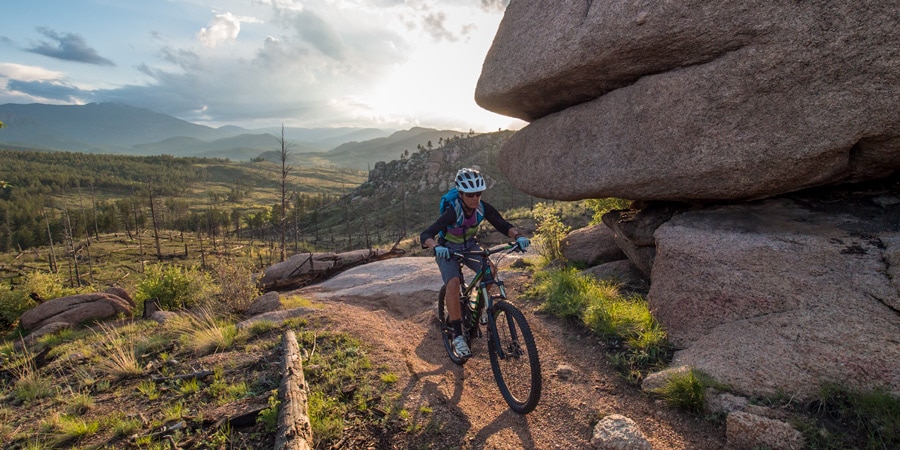Your favorite singletrack has finally thawed out and you're eager to ride outside after a long winter constantly checking trail conditions. Whether you're riding drop-offs or climbing steeps, your body may take a beating on those early rides if you're not bike-ready. Get in physical shape for the season with simple exercises designed to help prevent common mountain biking injuries, such as pain in your knees, wrists and lower back.
There's no substitute for miles in the saddle, but you can also improve your performance off the bike as well. This exercise plan was developed to complement riding time.
Here's a general overview of how to train for mountain biking:
- Build strength. Target muscles you rely on most to power your pedaling strokes: your quads, hamstrings and abdominals.
- Increase your endurance. Avoid getting winded too soon or packing it in early because of tired legs.
- Improve your mountain bike skills. Ride faster, harder and more efficiently by improving your bike handling and other technical skills.
Before beginning any training plan, check in with your doctor or certified training professional.
Training Schedule for Mountain Biking
Start these exercises about 6 to 8 weeks before you plan to start riding intensely. Complement your workouts with riding time on the bike, whether you're training using an indoor bike trainer or riding outside.
Training Exercises for Mountain Biking
Keep the following in mind as you train:
- Modify an exercise or skip it if something doesn't feel right.
- Train at your own pace, starting slowly at first. Increase the number of reps over time as you build strength and endurance.
Warm up. Prep your body with five to 10 minutes of light cardio activity. You can hop on a treadmill or elliptical machine, go for a quick jog or even jump rope. Then follow these guidelines:
- Inhale during initial exertion, then exhale as you return to the starting position. Make sure you breathe regularly during faster exercises.
- When you first start these exercises, rest for 60 to 90 seconds between each. As you feel more fit or if you want more of a cardio challenge, rest for 30 to 45 seconds.
- Perform the full set of exercises two to three times.
Nerve Glide Exercise
The goal of this exercise is to help prevent numbness in your hands, which can happen when you grip your handle bars too tightly or for long periods of time. It helps the median nerve that runs through the carpal tunnel.
Prop: None
- Stand or sit facing forward with your left arm extended out to the side with your palm up. Bend your elbow as though you were holding a tray on your open hand.
- Slowly tilt your head so that it leans toward the left shoulder; as you do so, also straighten your left elbow and extend your left arm.
- Return your head and hand to the starting position.
- Do this 15 times; then repeat the exercise 15 times on the opposite side.
Tips and modifications: The goal is for smooth, simultaneous movement of your head and hand; if you feel any tension along your arm as you move, then slow down until you can synchronize movement without feeling that tension.
Walking Lunge with Rotation Exercise
The following exercise helps warm up your quads, hips and core to get it ready for the exercises that follow. These are areas of your body you'll engage most when mountain biking.
Prop: None
- Stand with your feet slightly apart.
- Step one foot forward into a lunge. Your back knee should drop at a 90-degree angle to the ground. Your forward knee should also be at a 90-degree angle.
- As you step forward, rotate your body to the side in the direction of your lead knee. Have arms at chest height, slightly elevated from your sides.
- Drive up and through your forward leg to take the next lunge step. Your back knee should now be out front.
- Repeat 10 times each side for a total of 20.
Tips and modifications: If you don't have enough space, you can stay in one spot and alternate your legs. Make it easier by keeping your back leg straight. Make sure that your knees do not go inward, and stay in a straight line with your foot and hip.
Lateral Ski Jump Exercise
This exercise targets the glutes, quads, hamstrings and calf muscles which power the push and pull of your pedaling stroke.
Prop: None
- Stand with your feet hip-width apart and knees slightly bent, balancing on one leg.
- Jump to the side, landing on the other leg. Think about landing softly with your knee slightly bent.
- Then jump to the other side, landing on the other leg.
- Swing your arms sideways across your body like a speed skater.
- Repeat 15 on each side for a total of 30.
Tips and modifications: If you find this exercise too challenging, make smaller jumps to the side, move slower or touch your toe to the ground rather than keeping it off the floor.
Burpee Exercise
This plyometric exercise (essentially jump training) targets your entire body. It works your quads, glutes, hamstrings, calves, abs, arms, chest and triceps. It will prepare you for the explosive bursts you'll need when climbing steep hills or riding over uneven terrain.
Prop: None
- Stand with your feet shoulder-width apart and arms at your sides.
- Explode straight up to jump off the ground while reaching your hands up over your head.
- Land softly with knees bent and in one smooth motion, squat down, place your hands down on the ground in front of you and kick both feet back so you're in a plank position.
- Now jump your feet in toward your hands then explode straight up to start the next burpee.
- Do 10-15 repetitions.
Tips and modifications: Instead of kicking both feet back when you are in a plank position, you can make this exercise easier by stepping one foot back at a time.
Bridge with Hamstring Curl
This exercise strengthens your glutes and hamstrings for more powerful and efficient pedaling; these muscles also help support your knees.
Prop: Large exercise ball
- Lie on your back with your arms extended down by your sides, with your legs extended and your heels resting atop the exercise ball.
- Tighten your glutes and abs as you pull your legs back, rolling the ball toward your butt.
- Stop when your knees are bent at slightly more than 90 degrees.
- Extend your legs straight again, rolling the ball away from you.
- Repeat the sequence 15 times.
Tips and modifications: If you struggle to maintain balance as you roll the ball, place your heels slightly farther apart on the ball and move your arms away from your body; increase difficulty by keeping your heels closer together and by moving your arms closer to your body.
Back Extension Exercise
This exercise works the muscles of your lower back to keep you stable and support your body, particularly as you spend hours hunched over your mountain bike and riding rocky terrain.
Prop: Exercise ball (23-inch diameter or smaller is ideal)
- Lay with your stomach on the exercise ball
- Cross your arms in front of you so your elbows are level with your shoulders.
- Slowly lift your shoulders up until your body forms a straight line. Keep your chin tucked a bit to keep head in neutral.
- Lower your shoulders back down, taking the shape of the ball.
- Repeat 15-20 times.
Tips and modifications: Avoid overarching your back.
Plank with Single Arm Row
The plank targets your abdominals and improves core and neck stability. The rowing element also works your lats and shoulders. Keeping your core strong will protect your lower back during long, hard rides. A strong core helps maintain proper riding position, allowing you to put less pressure on your forearms, wrists and hands.
Prop: Two moderate-weight dumbbells
- Begin in a plank position with hands on dumbbells and feet set wide apart.
- Row one elbow back, bringing the dumbbell up toward your rib cage.
- Return dumbbell to ground and repeat.
- Maintain a plank position throughout the exercise by keeping the body straight from head to toe. Do not let hips rotate; keep chin slightly tucked looking at the ground ahead of you to better engage neck muscles.
- Do 10-15 reps on each arm.
Tips and modifications: If you are unable to maintain a stable trunk while on your feet, drop to your knees to complete the exercise. You can also use a lighter or heavier dumbbell.
Single-Leg Deadlift Exercise
Engage your glutes and hamstrings, the large muscles responsible for pedaling power in the pull stroke. These muscles also support and stabilize your knees and help protect them from strain or injury.
Prop: Moderate-weight dumbbell
- Stand with feet shoulder-width apart, holding a dumbbell in your left hand.
- Centering your weight over your right foot, bend forward at the hips as you extend your left leg backwards; maintain your balance as you lower the dumbbell toward the floor. Do not let your hips rotate.
- Raise back up to the start position by squeezing your glutes; your core should remain engaged and your back should remain straight.
- Do this 20 times; then switch to your other side and do 20 reps.
Tips and modifications: Modify the difficulty by adjusting how far down you bend toward the floor. You can also use a lighter or heavier dumbbell.
Improve Your Mountain Bike Skills
Become a better mountain biker by nailing mountain biking basic techniques. And then work on progressing through more intermediate skills such as bike cornering or jumping.

